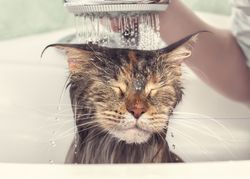
A skin condition can be extremely uncomfortable for a cat, causing frequent itching and licking, hindering the growth of a full and protective coat. However, many cats are experts at masking their pain and distress, so it can be easy for a pet owner to miss the presence of a feline skin problem. To better understand your cat and their skin, as well as the ways a pet dermatologist can help, below are some common conditions.
A Guide to Common Feline Skin Conditions
1. Fleas
Cats can easily pick up fleas, and indoor cats are not immune if there are other animals in the home. Fleas are tiny insects that consume the blood of warm-blooded mammals. Though fleas can hide anywhere in your cat's fur, they gravitate toward the warmest spots, like in the ears and under the tail.
They will make a cat scratch and bite and produce red patches of skin. A pet dermatologist can prescribe flea treatments, which may be topical or oral, and help rid your cat of these painful pests.
2. Allergies
 Skin conditions can stem from any number of different allergic reactions. A cat can react to certain triggers in the environment, such as pollen, dust, smoke, grooming products, or household cleaners. Other causes for skin allergies include food items like dairy, wheat, additives, or fillers, along with other animals and bites from insects.
Skin conditions can stem from any number of different allergic reactions. A cat can react to certain triggers in the environment, such as pollen, dust, smoke, grooming products, or household cleaners. Other causes for skin allergies include food items like dairy, wheat, additives, or fillers, along with other animals and bites from insects.
An allergic reaction in a cat looks much the same as it does in a human. This can include symptoms of increased itchiness, sneezing and wheezing, and, in severe cases, anaphylactic shock. A pet dermatologist will perform a variety of tests to help determine what allergies your cat has and the most effective ways of minimizing exposure and managing symptoms. In many cases, antihistamines are the first line of defense.
3. Ringworm
Ringworm is a fungal infection that creates raised red circles on the skin. However, these marks are sometimes difficult to spot because of a cat's fur. Instead, look for dry, scaly patches of skin and balding spots, especially on the head, chest, and front of the legs. A pet dermatologist typically treats ringworm with oral medication and antifungal shampoos.
If you suspect your cat is suffering from a skin problem, take them to a pet dermatologist as soon as possible. Veterinary Dermatology Services serves pets throughout Ohio, Northern Kentucky, and Southern Indiana. They offer comprehensive animal skin care services, including allergy consulting, skin disease treatments, and laser surgeries. Call (513) 489-4644 or visit them online to schedule an appointment.
About the Business
Have a question? Ask the experts!
Send your question

